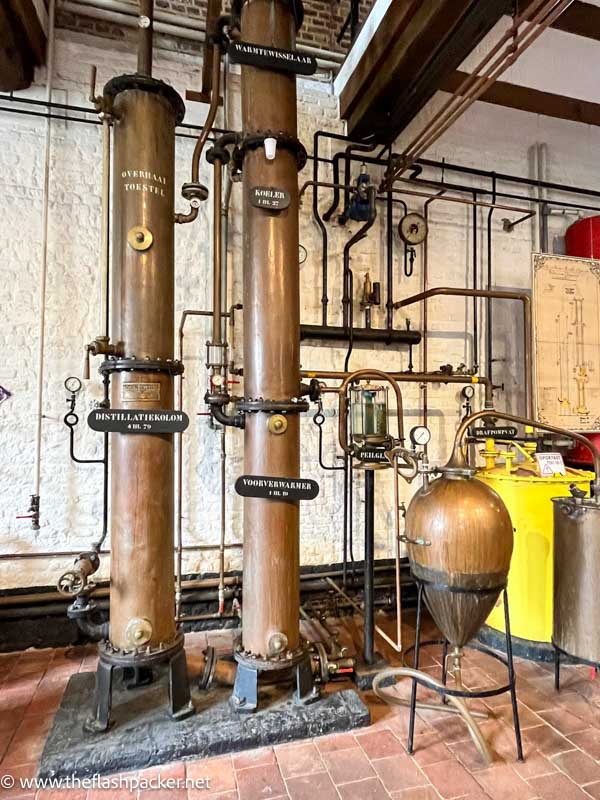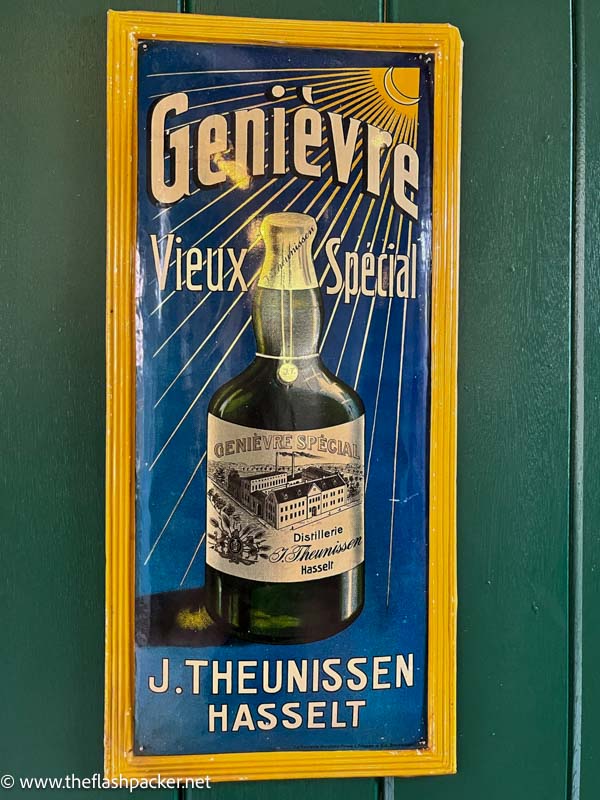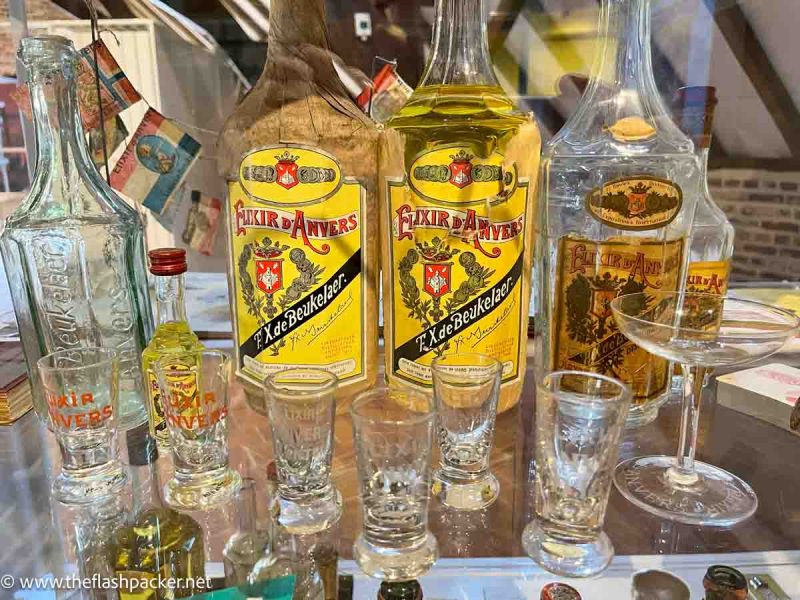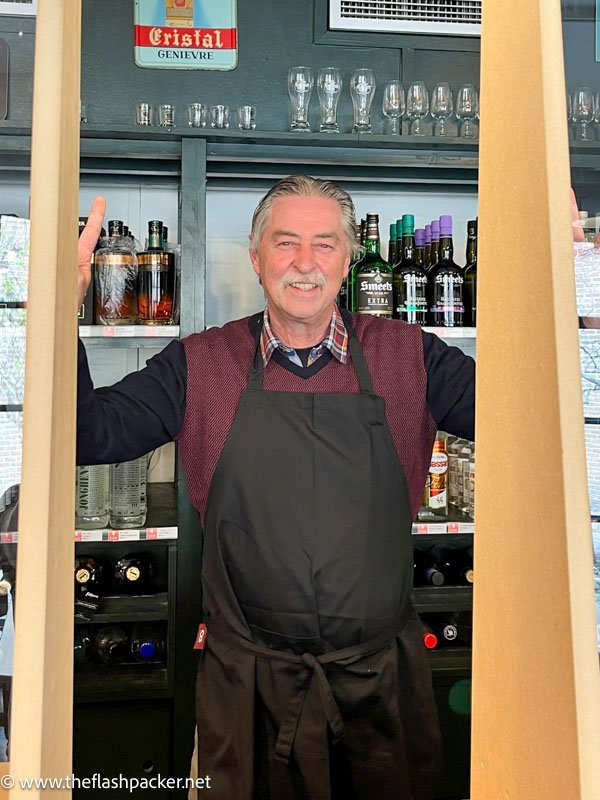Have a drink, it’s educational
The Jenever Museum Hasselt must have one of the best straplines ever. And this is not far wrong. By the end of your visit, you’ll be a jenever expert.
The lovely city of Hasselt is famous for its street art, its lovely Japanese garden (Japanse Tuin Hasselt) and its museum dedicated to jenever, Belgium’s favourite tipple. Hasselt is also an easy day trip by train from major cities, including Brussels, Antwerp and Leuven.
Take a break from beer and try Belgian gin at the Jenever Museum in Hasselt (Jenevermuseum Hasselt). Here’s how to do it and what to expect.

Introducing Jenever
Jenever, also known as genever, is a grain-based alcoholic spirit. Like gin, it is made from juniper berries but predates its better-known cousin.
The earliest records of jenever production are from 13th Century Belgium, and the Dutch introduced it to the UK in the late 16th Century.
The liberal consumption of jenever by soldiers before going into battle gave rise to the expression “Dutch courage”.
What to Expect from Your Visit to the Jenever Museum, Hasselt
Housed in a restored, fully operational 19th-century distillery, the gin museum in Hasselt focuses on the history and production of jenever through its impressive collection of artefacts. This includes glass bottles, stone jugs and pitchers, glasses, posters and bottle labels.
After buying your ticket at the reception in the distillery’s former ox house, the first part of your visit takes you through its distillation and mill room, malting tower and germination loft.
A showpiece of the museum is a 19th-century steam distillation system from the Servais distillery in Gérmont-Malmèdy. It is still draped in the cobwebs which proved extremely effective in catching the flies attracted by the fermentation process.

Production of jenever begins with mixing grains of corn with water and yeast, turning them into sugars. Alcohol distilled from the mixture (“mash”) is added to juniper berries and other botanicals. The exact recipe at Hasselt’s jenever is a closely guarded secret.
But distilling jenever is just the start of the story. The drink has to be bottled, transported and promoted.
Jenever was initially supplied in casks and large jars but by the middle of the 17th Century, a distinctive square bottle was the vessel of choice. By the second half of the 19th Century, stone crocks were used which were later imitated in glass.
Like any other industry, promotion was important and the museum has an extensive range of marketing materials. This includes matchboxes, ashtrays, coin dishes and coasters.
Posters and placards were crucial in spreading the word and there is a fascinating range of styles at the museum, from the lithographic posters of the late 19th Century to Art Nouveau to the 1970s. There’s even a fun quiz where you can guess the time period of the poster.

Genever was the prime target of the persistent anti-alcohol campaigns of the 19th and early 20th centuries. With sales tanking, distilleries switched to the production of elixir. This fluorescent yellow liqueur was sweeter and was marketed as a health drink.

The next part of your museum tour takes you through four rooms of a house that was built in 1829. Exhibits in these rooms further explore the history of jenever production and consumption in Belgium.
Did you know that women are more susceptible to the effects of alcohol due to having a lower concentration of alcohol dehydrogenase, the enzyme that breaks it down, and a lower body water content to dilute it? Within a modernised 19th Century barn you learn more about the positive and negative effects of booze.
Finally, complete your visit with a spot of empirical research at the tasting bar. Your admission ticket includes a coupon for one free tasting.
The Museumjenever Hasselt distils four products:
- Grain jenever distilled according to a 19th-century recipe
- Mature grain jenever
- Elixir
- Oranjebitter
The cheerful staff will be only too happy to make a recommendation based on your general booze preferences.

For me, it was the original grain jenever, which was delicious. Don’t slam your jenever like a tequila shot; this should be sipped and savoured.
Plan Your Visit to the Jenever Museum, Hasselt
Opening hours & ticket price
The Jenever Museum Hasselt is open from Tuesday to Sunday, 10 am to 5 pm (last entry at 4 pm). It is closed on Mondays and on December 24th, 25th, 31st and January 1st.
In 2024, an adult admission ticket costs €7. This cost can change during special exhibitions. Check the museum’s website for up-to-date information.
You don’t need a museum ticket to visit the tasting room.
GETTING THERE
Hasselt’s Jenever Museum is located at Witte Nonnenstraat 19, 3500 Hasselt. It is a 20-minute walk from the train station.
Trains leave Antwerp and Brussels every 30 minutes for Hasselt. The average journey time is around 70/80 minutes respectively.
Frequent trains also run between Hasselt and Leuven (40 minutes).
Enjoy gin tasting in Hasselt!
I certainly did.
Why not combine your visit to the Jenever Museum with Hasselt’s Japanese Garden? It’s the biggest and one of the best of its kind in Europe.
If you have found this guide helpful and are planning further travel in Belgium, take a peek at my other articles (here’s my one-week Belgium itinerary for starters)
Brussels and Ghent are terrific bases for exploring Belgium by train. If you are a chocoholic, spend a day hunting for the best chocolate shops in Bruges.
Consider some of its more under-the-radar destinations (my day in Mechelen was a treat). I also loved my day trip to Leuven, which is home to De Kruidtuin Leuven, the oldest botanical garden in Belgium.
Happy travels!

About Bridget
Bridget Coleman has been a passionate traveller for more than 30 years. She has visited 70+ countries, most as a solo traveller.
Articles on this site reflect her first-hand experiences.
To get in touch, email her at hello@theflashpacker.net or follow her on social media.
